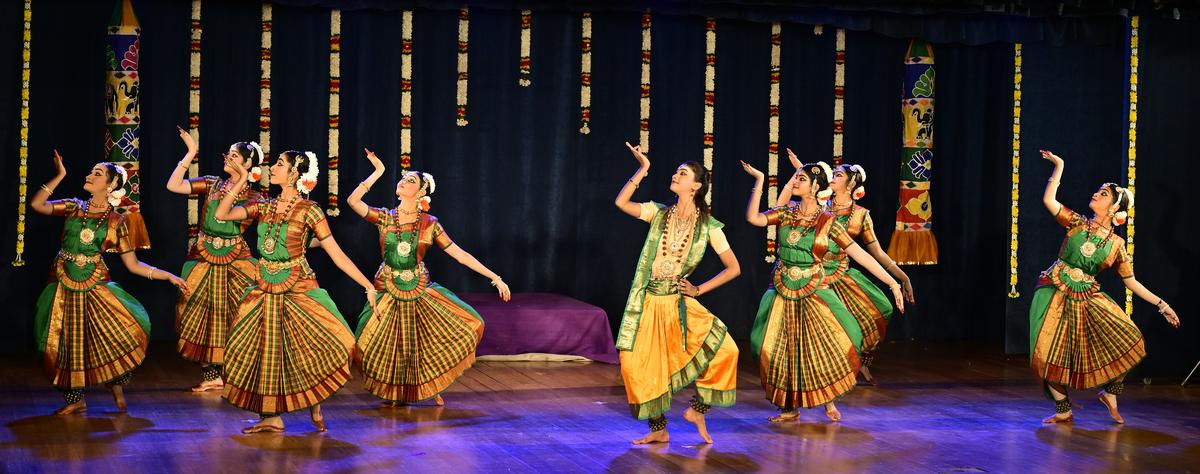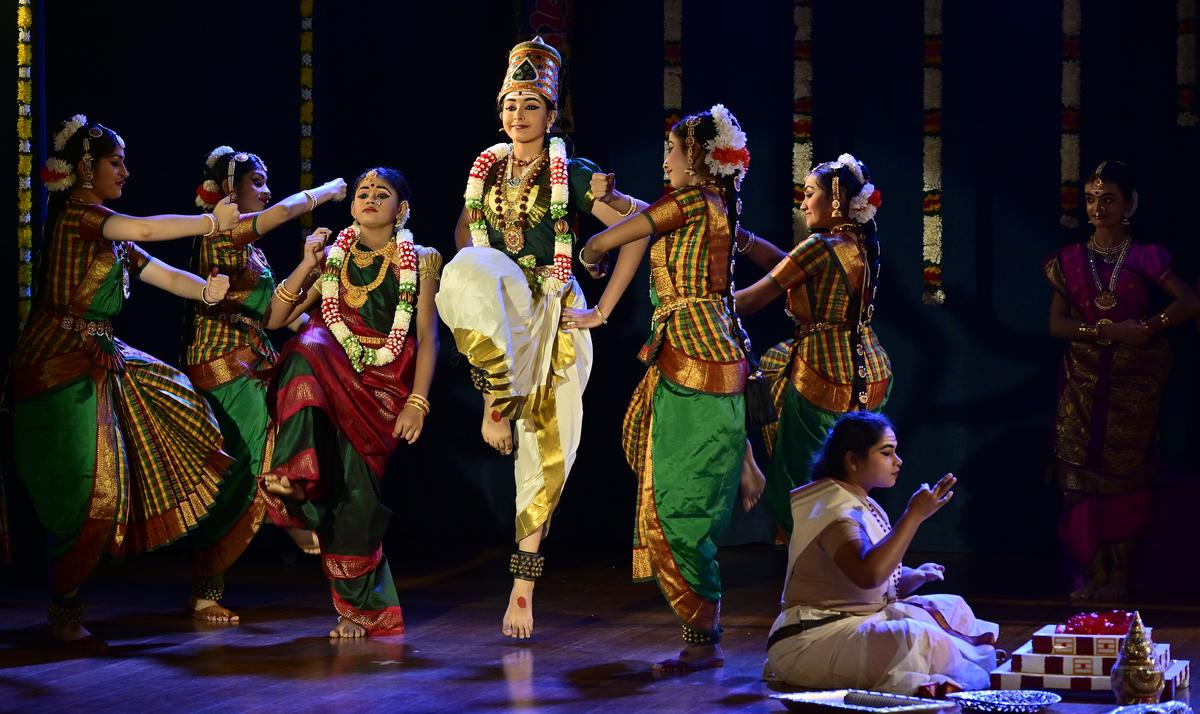From Sankara Natyalaya ‘Aadhi Saivam Arooran’, held at R.R. Sabha in Chennai
| Photo Credit: B. VELANKANNI RAJ
Curated costume, compelling storytelling, appropriate character selection, well-chosen props, and dynamic dance moves — ‘Aadhi Saivam Arooran’ had it all. As part of the 11th-anniversary celebration of Sankara Natyalaya, this thematic production based on the life of Sundaramurthy Nayanar was presented by the students. It was conceptualised and choreographed by Kanaka Krishna Prashant. The songs were drawn from the Periya Puranam and Sundarar Thevaram. Additional credits for the evening go to G.V. Guru Bharadwaaj for his jathis and support on the mridangam, T.V. Sukanya (violin), and Sowmya Ramesh (veena). The resource persons were R. Subramaniam and Uma Subramaniam.
The thematic presentation highlighted how the Tiruvarur Temple is known not only for Shiva and Parvati (Neelotpalambika) but also for Shiva’s dear friend, Sundara Nayanar. Once, while Sundara was in the garden plucking flowers, he meets two women, Anandithai and Kamalini, and is instantly drawn towards them. Shiva, aware of this, grants Sundara the opportunity to be born on earth and fulfill his desire. In response, Sundara says, “How can I leave you? You must protect me at the right time.”

The performance had interesting group formations
| Photo Credit:
B. VELANKANNI RAJ
The presentation was carefully segmented, and before each episode, a little girl in a pavadai-chattai and her grandmother, wearing a nine-yard sari, (played by the students) narrated the story through their conversation. The segments also featured fast-paced moves with intricate formations, all performed in synchrony.
Sundarar, born to Sadaiya Nayanar and Isaignaniyar in Thirunavalur, was known for his exceptional beauty and was adopted by king Narasinga Munaiaraiyar. When Sundarar grew up, the king arranged for his marriage, but not to Anandithai or Kamalini. Hence, on the wedding day, lord Shiva appeared disguised as an old man, holding a palm leaf, which stated that Sundarar was bound to serve him. Interpreting this as a divine command, Sundarar cancels the wedding and dedicates himself to the service of Lord Shiva at the Tiruvarur temple, beginning his first poem with the words ‘Pittaa pirai chudi’.

The costumes, props and choreography were impressive
| Photo Credit:
B. VELANKANNI RAJ
Props and costumes were key features in the thematic presentation. An innovative touch was when the dancer portraying the old man entered from the main door of the R.R. Sabha auditorium.
The subsequent sections of the thematic presentation depicted Sundarar’s journey across Tamil Nadu, visiting Shiva temples. In Tiruvarur, he falls in love and marries temple dancer named Paravayar (Kamalini in previous birth). Years later, while visiting the Shiva temple in Thiruvottriyur, a coastal suburb of Madras, Sundarar is enamoured by a peasant girl named Cankali (Anandithai in previous birth). With Shiva’s help, he marries Cankali, vowing never to leave her or Thiruvottiyur. However, longing for Paravayar, Sundarar breaks his vow and returns to Tiruvarur. As a result, he becomes blind. His subsequent hardships are reflected in several Tevaram hymn. Through his devotion, he eventually regains sight.
In a scene featuring demons, the young girls were impressive. In scenes that relied solely on expressions, the dancers conveyed well the emotions.
The thematic presentation concluded with the final chapter of the story, where Upamanyu, the child of Vyaghrapada, follows Sundarar on his journey to Kailasha, incorporating thillana into the dance moves. According to the Periya Puranam, Upamanyu narrates Sundarar’s story.